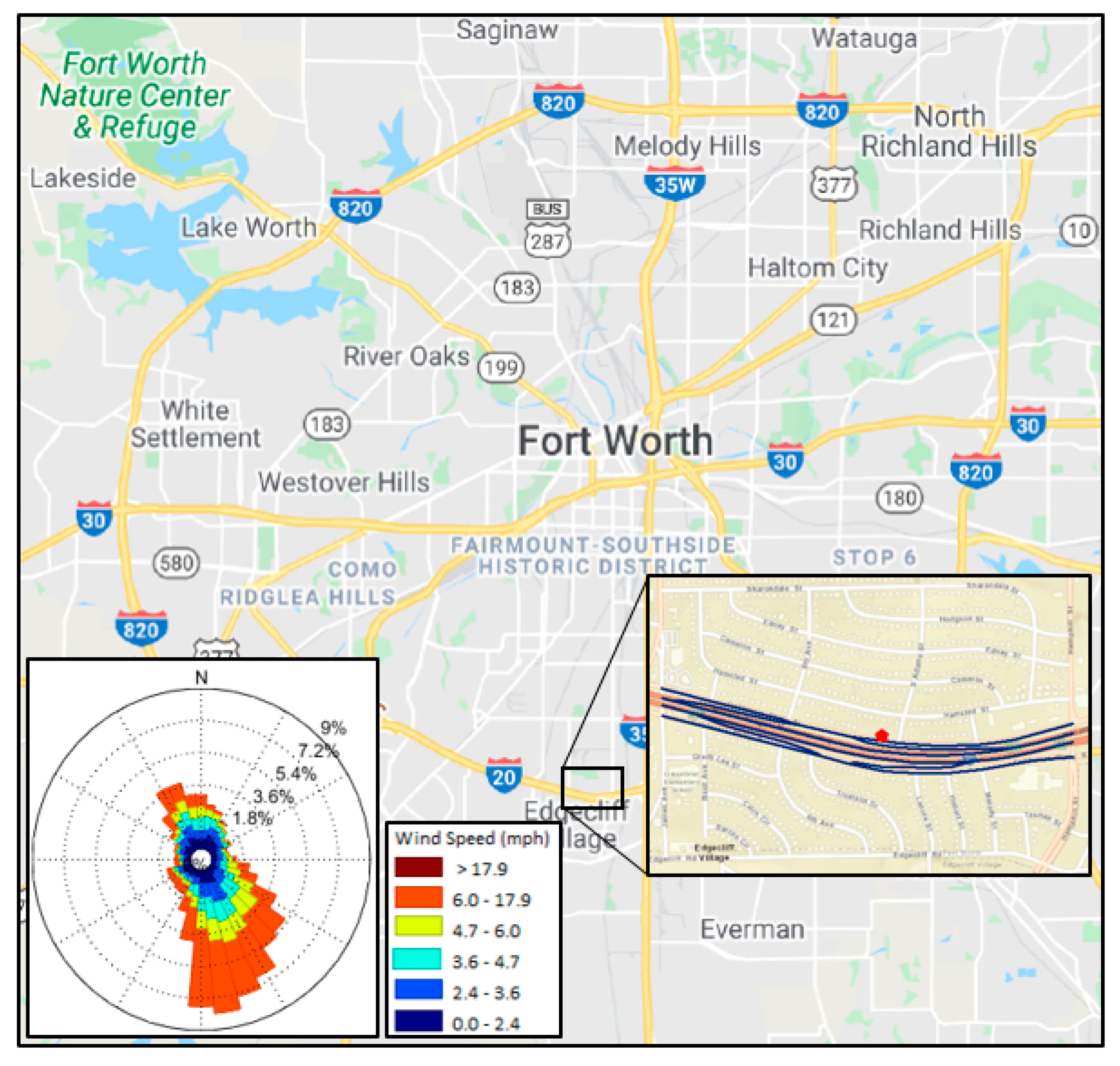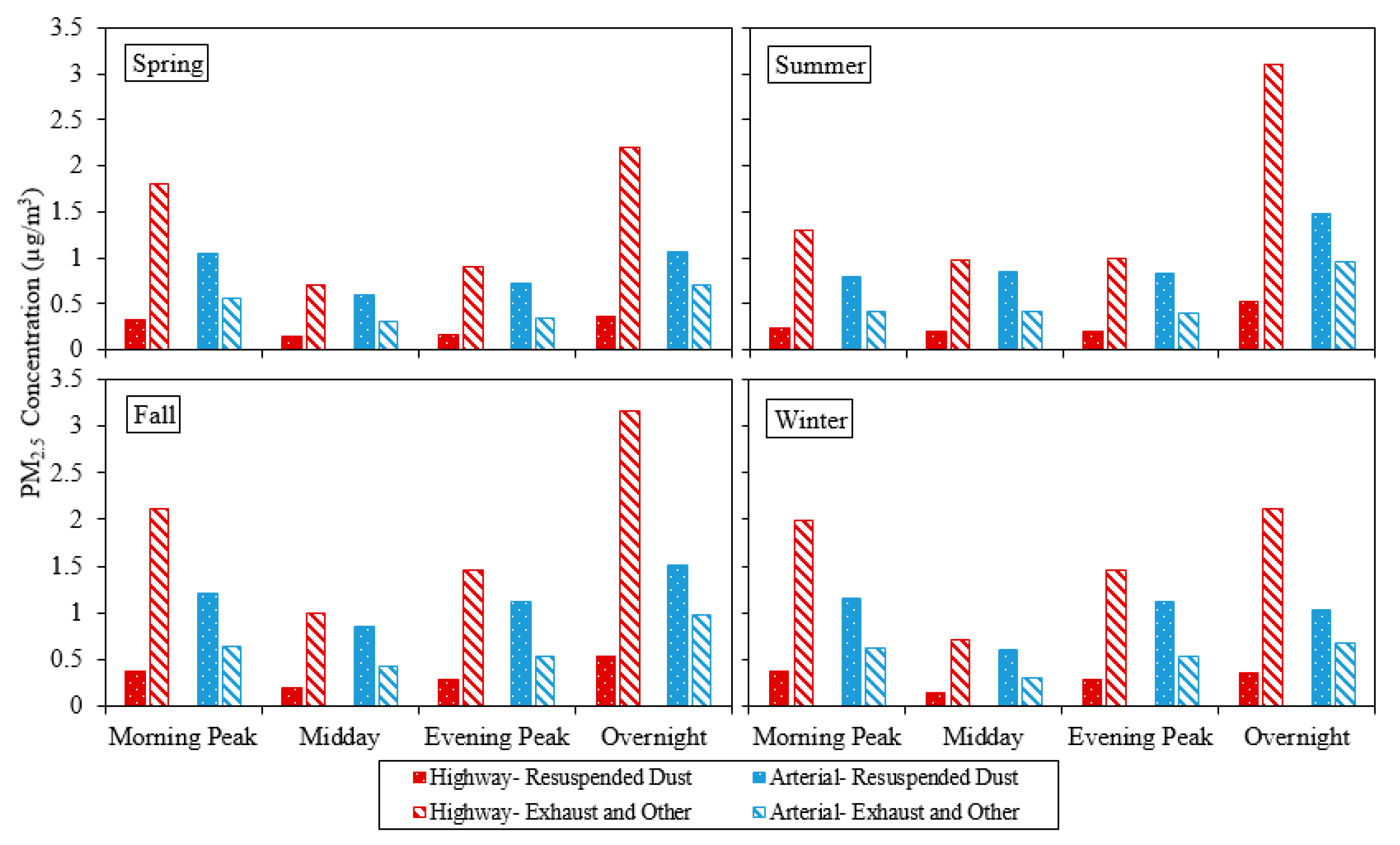Near-Road Traffic-Related Air Pollution: Resuspended PM2.5 from Highways and Arterials
Abstract
:1. Introduction
2. Materials and Methods
2.1. Theoretical Premise
2.2. Area of Study
2.3. Emission Modeling Using MOVES
2.4. Resuspended Dust Emission Estimation
2.5. Dispersion Modeling Using AERMOD
3. Results and Discussion
3.1. Traffic-Related PM2.5 Emission Rates on Highways and Arterials
3.2. Traffic-Related PM2.5 Concentrations from Highways and Arterials
3.3. Overall Traffic-Related PM2.5 Concentrations
4. Conclusions and Recommendations
Author Contributions
Funding
Conflicts of Interest
References
- Khreis, H.; Warsow, K.M.; Verlinghieri, E.; Guzman, A.; Pellecuer, L.; Ferreira, A.; Jones, I.; Heinen, E.; Rojas-Rueda, D.; Mueller, N.; et al. The health impacts of traffic-related exposures in urban areas: Understanding real effects, underlying driving forces and co-producing future directions. J. Transp. Health 2016, 3, 249–267. [Google Scholar] [CrossRef]
- Weinmayr, G.; Romeo, E.; de Sario, M.; Weiland, S.; Forastiere, F. Short-term effects of PM10 and NO2 on respiratory health among children with asthma or asthma-like symptoms: A systematic review and meta-analysis. Environ Health Perspect. 2010, 118, 449–457. [Google Scholar] [CrossRef] [PubMed] [Green Version]
- Zamora, M.L.; Pulczinski, J.C.; Johnson, N.; Garcia-Hernandez, R.; Rule, A.; Carrillo, G.; Zietsman, J.; Sandragorsian, B.; Vallamsundar, S.; Askariyeh, M.H.; et al. Maternal exposure to PM2.5 in south Texas, a pilot study. Sci. Total Environ. 2018, 628–629, 1497–1507. [Google Scholar] [CrossRef] [PubMed]
- Sohrabi, S.; Zietsman, J.; Khreis, H. Burden of Disease Assessment of Ambient Air Pollution and Premature Mortality in Urban Areas: The Role of Socioeconomic Status and Transportation. Int. J. Environ. Res. Public Health 2020, 17, 1166. [Google Scholar] [CrossRef] [Green Version]
- Sharifi, F.; Sohrabi, S.; Farzaneh, R.; Khreis, H. Active Transportation and Self-Impression of Health: Evidence from 2017 National Household Travel Survey Data. J. Transp. Health 2019, 14, 100786. [Google Scholar] [CrossRef]
- Sohrabi, S.; Khreis, H. Transportation and Public Health: A Burden of Disease Analysis of Transportation Noise. J. Transp. Health 2019, 14, 100686. [Google Scholar] [CrossRef]
- U.S. EPA. NAAQS Table. Criteria Air Pollutants. 2016. Available online: https://www.epa.gov/criteria-air-pollutants/naaqs-table (accessed on 15 February 2018).
- Askariyeh, M.H.; Vallamsundar, S.; Farzaneh, R. Investigating the Impact of Meteorological Conditions on Near-Road Pollutant Dispersion between Daytime and Nighttime Periods. Transp. Res. Rec. 2018, 2672, 99–110. [Google Scholar] [CrossRef]
- Baldauf, R.; Thoma, E.; Hays, M.; Shores, R.; Kinsey, J.; Gullett, B.; Kimbrough, S.; Isakov, V.; Long, T.; Snow, R.; et al. Traffic and Meteorological Impacts on Near-Road Air Quality: Summary of Methods and Trends from the Raleigh Near-Road Study. J. Air Waste Manag. Assoc. 2008, 58, 865–878. [Google Scholar] [CrossRef]
- Askariyeh, M.H.; Vallamsundar, S.; Zietsman, J.; Ramani, T. Assessment of Traffic-Related Air Pollution: Case Study of Pregnant Women in South Texas. Int. J. Environ. Res. Public Health 2019, 16, 2433. [Google Scholar] [CrossRef] [Green Version]
- Askariyeh, M.H.; Zietsman, J.; Autenrieth, R. Traffic Contribution to PM2.5 Increment in the Near-Road Environment. Atmos. Environ. 2020, 224, 117113. [Google Scholar] [CrossRef]
- Chen, S.; Broday, D.M. Re-framing the Gaussian dispersion model as a nonlinear regression scheme for retrospective air quality assessment at a high spatial and temporal resolution. Environ. Model. Softw. 2020, 125, 104620. [Google Scholar] [CrossRef]
- Kioumourtzoglou, M.-A.; Schwartz, J.D.; Weisskopf, M.G.; Melly, S.J.; Wang, Y.; Dominici, F.; Zanobetti, A. Long-term PM2.5 Exposure and Neurological Hospital Admissions in the Northeastern United States. Environ. Health Perspect. 2016, 124, 23–29. [Google Scholar] [CrossRef] [PubMed] [Green Version]
- Girguis, M.S.; Strickland, M.J.; Hu, X.; Liu, Y.; Bartell, S.M.; Vieira, V.M. Maternal Exposure to Traffic-Related Air Pollution and Birth Defects in Massachusetts. Environ. Res. 2016, 146, 1–9. [Google Scholar] [CrossRef] [PubMed] [Green Version]
- Weinstock, L.; Watkins, N.; Wayland, R.; Baldauf, R. EPA’s Emerging Near-Road Ambient Monitoring Network: A Progress Report. EM Magazine. Available online: http://pubs.awma.org/gsearch/em/2013/7/weinstock.pdf (accessed on 20 March 2020).
- Vallamsundar, S.; Askariyeh, M.; Zietsman, J.; Ramani, T.; Johnson, N.; Pulczinski, J.C.; Koehler, K. Maternal Exposure to Traffic-Related Air Pollution Across Different Microenvironments. J. Transp. Health 2016, 3, S72. [Google Scholar] [CrossRef]
- Brugge, D.; Durant, J.; Rioux, C. Near-highway pollutants in motor vehicle exhaust: A review of epidemiologic evidence of cardiac and pulmonary health risks. Environ. Health 2007, 6, 23. [Google Scholar] [CrossRef] [Green Version]
- Rowangould, G.M. A census of the US near-roadway population: Public health and environmental justice considerations. Transp. Res. Part D Transp. Environ. 2013, 25, 59–67. [Google Scholar] [CrossRef]
- U.S. EPA. Transportation Conformity Guidance for Quantitative Hot-Spot Analyses in PM2.5 and PM10 Nonattainment and Maintenance Areas, Office of Transportation and Air Quality. EPA-420-B-15-084. 2015. Available online: https://www3.epa.gov/ttn/naaqs/aqmguide/collection/cp2/20101201_otaq_epa-420_b-10-040_transport_conform_hot-spot_analysis_appx.pdf (accessed on 2 March 2018).
- U.S. EPA. MOVES2014a User Guide. Office of Transportation and Air Quality. 2015. Available online: https://nepis.epa.gov/Exe/ZyPDF.cgi?Dockey=P100NNCY.txt (accessed on 15 March 2018).
- U.S. EPA. Control of Air Pollution from Motor Vehicles: Tier3 Motor Vehicle Emission and Fuel Standards Final Rule. 2014. Available online: https://www.epa.gov/regulations-emissions-vehicles-and-engines/final-rule-control-air-pollution-motor-vehicles-tier-3 (accessed on 20 February 2018).
- Amato, F.; Favez, O.; Pandolfi, M.; Alastuey, A.; Querol, X.; Moukhtar, S.; Bruge, B.; Verlhac, S.; Orza, J.A.G.; Bonnaire, N.; et al. Traffic induced particle resuspension in Paris: Emission factors and source contributions. Atmos. Environ. 2016, 129, 114–124. [Google Scholar] [CrossRef]
- Thorpe, A.; Harrison, R.M. Sources and properties of non-exhaust particulate matter from road traffic: A review. Sci. Total Environ. 2008, 400, 270–282. [Google Scholar] [CrossRef]
- Abu-Allaban, M.; Gillies, J.A.; Gertler, A.W.; Clayton, R.; Proffitt, D. Tailpipe, resuspended road dust, and brake-wear emission factors from on-road vehicles. Atmos. Environ. 2003, 37, 5283–5293. [Google Scholar] [CrossRef]
- Kundu, S.; Stone, E.A. Composition and sources of fine particulate matter across urban and rural sites in the Midwestern United States. Environmental science. Process. Impacts 2014, 16, 1360–1370. [Google Scholar] [CrossRef] [Green Version]
- ADOT. Air Quality Regional Conformity Analysis: Nogales PM2.5–PM10 Nonattainment Areas. Arizona Department of Transportation (ADOT) Project No. 189 SC 000 H8045 01L. 2017. Available online: https://www.azdot.gov/docs/default-source/environmental-planning-library/h8045_nogales_finalairqualityconformityanalysis.pdf?sfvrsn=2 (accessed on 10 April 2018).
- U.S. EPA. Using MOVES2014 in Project-Level Carbon Monoxide Analyses. 2015. Available online: https://nepis.epa.gov/Exe/ZyPdf.cgi?Dockey=P100M2FB.pdf (accessed on 15 March 2018).
- U.S. EPA. AP-42: Section 13.2.1 Paved Roads. Available online: https://www3.epa.gov/ttnchie1/ap42/ch13/final/c13s0201.pdf (accessed on 20 March 2018).
- U.S. EPA. User’s Guide for the AMS/EPA Regulatory Model (AERMOD). Office of Air Quality Planning and Standards: Research Triangle Park, NC. EPA-454/B-19-027. 2019. Available online: https://www3.epa.gov/ttn/scram/models/aermod/aermod_userguide.pdf (accessed on 20 March 2020).
- Zhu, Y.; Kuhn, T.; Mayo, P.; Hinds, W. Comparison of Daytime and Nighttime Concentration Profiles and Size Distributions of Ultrafine Particles near a Major Highway. Environ. Sci. Technol. 2006, 40, 2531–2536. [Google Scholar] [CrossRef] [PubMed]
- Ginzburg, H.; Liu, X.; Baker, M.; Shreeve, R.; Jayanty, R.; Campbell, D.; Zielinska, B. Monitoring study of the near-road PM2.5 concentrations in Maryland. J. Air Waste Manag. Assoc. 2015, 65, 1062–1071. [Google Scholar] [CrossRef] [PubMed] [Green Version]
- Zhao, S.; Yu, Y.; Yin, D.; He, J.; Liu, N.; Qu, J.; Xiao, J. Annual and diurnal variations of gaseous and particulate pollutants in 31 provincial capital cities based on in situ air quality monitoring data from China National Environmental Monitoring Center. Environ. Int. 2016, 86, 92–106. [Google Scholar] [CrossRef] [PubMed]
- Code of Federal Register. Title 40CFR Part 58, Appendix D, Section 4.3.2. 2017. Available online: https://www.ecfr.gov/cgi-bin/retrieveECFR?gp=&r=PART&n=40y6.0.1.1.6 (accessed on 20 April 2018).
- U.S. EPA. Ambient Monitoring Technology Information Center (AMTIC). 2019. Available online: https://www3.epa.gov/ttnamti1/nearroad.html (accessed on 20 March 2020).
- Texas A&M Transportation Institute. Update of On-Road Inventory Development Methodologies for MOVES2014. 2014. Available online: ftp://amdaftp.tceq.texas.gov/pub/EI/onroad/mvs14_utilities/MOVES2014_Utilities_Report_Final_December_2014.pdf (accessed on 10 May 2018).
- Texas A&M Transportation Institute. Methodologies for Conversion of Data Sets for MOVES Model Compatibility. 2013. [Google Scholar]
- CoCoRaHS. Community Collaborative Rain, Hail and Snow Network: Daily Precipitation Reports. 2017. Available online: https://www.cocorahs.org/ViewData/ListDailyPrecipReports.aspx (accessed on 25 March 2018).
- U.S. EPA. User’s Guide for the AERMOD Meteorological Preprocessor (AERMET). EPA-454/B-16-010. 2016. Available online: https://www3.epa.gov/ttn/scram/7thconf/aermod/aermet_userguide.pdf (accessed on 10 March 2018).
- TCEQ. Meteorological Data for Air Dispersion Modeling. 2017. Available online: https://www.tceq.texas.gov/permitting/air/nav/datasets.html (accessed on 16 May 2018).
- NOAA. Surface Air Database. 2018. Available online: ftp://ftp.ncdc.noaa.gov/pub/data/noaa (accessed on 16 May 2018).
- NOAA. NOAA/ESRL Radiosonde Database. 2018. Available online: https://ruc.noaa.gov/raobs/ (accessed on 16 May 2018).
- Sathaye, N.; Harley, R.; Madanat, S. Unintended environmental impacts of nighttime freight logistics activities. Transp. Res. Part A Policy Pract. 2010, 44, 642–659. [Google Scholar] [CrossRef] [Green Version]



| Time Period | Highway | Arterial | ||||||
|---|---|---|---|---|---|---|---|---|
| Spring | Summer | Fall | Winter | Spring | Summer | Fall | Winter | |
| Morning Peak | 17.4% | 18.4% | 18.1% | 17.5% | 172.7% | 181.3% | 178.4% | 175.6% |
| Midday | 18.1% | 18.7% | 18.6% | 18.6% | 187.4% | 193.0% | 192.2% | 193.1% |
| Evening Peak | 17.3% | 17.8% | 17.8% | 17.8% | 202.1% | 207.6% | 206.8% | 207.3% |
| Overnight | 15.7% | 16.4% | 16.2% | 16.2% | 138.9% | 144.1% | 142.9% | 144.8% |
| Time Period | Spring | Summer | Fall | Winter |
|---|---|---|---|---|
| Morning Peak | 58.5% | 60.2% | 57.8% | 58.3% |
| Midday | 73.1% | 73.8% | 74.3% | 73.3% |
| Evening Peak | 72.2% | 74.4% | 71.1% | 70.2% |
| Overnight | 49.6% | 49.4% | 49.5% | 49.8% |
© 2020 by the authors. Licensee MDPI, Basel, Switzerland. This article is an open access article distributed under the terms and conditions of the Creative Commons Attribution (CC BY) license (http://creativecommons.org/licenses/by/4.0/).
Share and Cite
Askariyeh, M.H.; Venugopal, M.; Khreis, H.; Birt, A.; Zietsman, J. Near-Road Traffic-Related Air Pollution: Resuspended PM2.5 from Highways and Arterials. Int. J. Environ. Res. Public Health 2020, 17, 2851. https://doi.org/10.3390/ijerph17082851
Askariyeh MH, Venugopal M, Khreis H, Birt A, Zietsman J. Near-Road Traffic-Related Air Pollution: Resuspended PM2.5 from Highways and Arterials. International Journal of Environmental Research and Public Health. 2020; 17(8):2851. https://doi.org/10.3390/ijerph17082851
Chicago/Turabian StyleAskariyeh, Mohammad Hashem, Madhusudhan Venugopal, Haneen Khreis, Andrew Birt, and Josias Zietsman. 2020. "Near-Road Traffic-Related Air Pollution: Resuspended PM2.5 from Highways and Arterials" International Journal of Environmental Research and Public Health 17, no. 8: 2851. https://doi.org/10.3390/ijerph17082851
APA StyleAskariyeh, M. H., Venugopal, M., Khreis, H., Birt, A., & Zietsman, J. (2020). Near-Road Traffic-Related Air Pollution: Resuspended PM2.5 from Highways and Arterials. International Journal of Environmental Research and Public Health, 17(8), 2851. https://doi.org/10.3390/ijerph17082851




